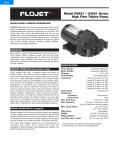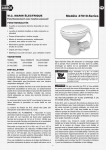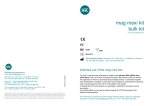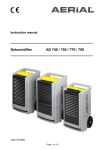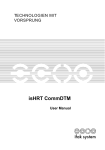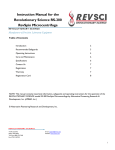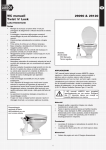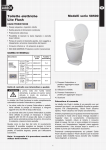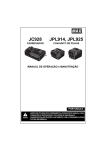Download Triplex Series High Pressure (Up to 150 PSI)
Transcript
Menu Triplex Series High Pressure (Up to 150 PSI) INSTALLATION & SERVICE INFORMATION Triplex Series, High Pressure FLOJET Triplex High Pressure Series pumps are designed for a wide range of applications and are constructed from a selection of materials suitable for handling a broad range of chemicals. The Triplex High Pressure diaphragm pumps are self-priming and can run dry without harm. They are intended for intermittent duty cycles but can be run continuously for short periods of time. The higher the duty cycle, the shorter the expected life of the pump. Typical uses include transfer, delivery, spraying, cooling, filtration, dispensing, and pressure boosting. OPERATION To start and prime the pump, the discharge line must be opened to allow trapped air to escape, thus avoiding the potential of airlock. For demand models, the pressure switch will shut off the pump automatically when the discharge valve is closed and the pressure has risen to the switch OFF set point. The pressure switch will restart the pump when a valve is opened and the discharge line pressure drops to the ON set point of the pressure switch. For bypass models, apply power to the pump, and open the discharge valve to expel air in the line. SPECIFICATIONS Pump Design: Motor Design: DEMAND OPERATION (intermittent duty) Pump models fitted with a pressure switch are known as demand pumps. The pressure switch is preset to shut off the pump motor automatically when a specific pressure is reached, such as in closed discharge conditions. The pressure switch turns the pump motor on automatically as the pressure drops, such as when the discharge is opened. Demand operation is considered an “intermittent duty” application. The maximum intermittent duty cycle is that which will cause the motor to reach its maximum thermal limits. Once the maximum thermal limit is reached, the motor must be allowed to settle to a lower (ideally ambient) temperature, before resuming operation. Running the pump at or near the maximum thermal limit for an extended period of time will shorten the life of the pump and may result in immediate pump failure. Demand pump models feature an integral pressure switch that automatically turns the pump off/on in response to open/closed discharge conditions. BYPASS OPERATION (if equipped) Models equipped with an external bypass system are designed to pump at high pressures while at low or high flow rates. Models equiped with bypass only must be turned off/on manually, or by an independent control device. Models equipped with a bypass only will continue to run until the power is manually turned off. The Triplex High Pressure pumps are not recommended for continuous duty service due to limited motor brush life. Operation at lower pressures and temperatures, however, will extend overall pump service life. Voltages: Cycles: Amp Draw: Pump Head: Elastomers: Motor operated 3 chamber diaphragm Permanent magnet DC and Rectified (PMDC) AC 12, 24 VDC 115, 230 VAC 50/60 Hz 9 amps max. for 12 VDC 0.95 amps max for 115 VAC Glass filled Nylon SantopreneTM EPDM or Viton Max. Flow Rate: 2.0 GPM (7.6 LPM) Max. Pressure: 150 psi (10.3 bar) switch cutoff 140 psi (9.7 bar) max running pressure Max. Liquid Temp: 40° F (4° C) Min* 160° F (71° C) Max Duty Cycle: Intermittent** Weight: 7.6 lbs (3.5 kg) max. Wiring Options: Standard 18 AWG leads 6 ft. (2 m) cord available for AC Certifications: UL, CE, NSF Components Port Size inlet / outlet: 3/8” NPTF Diaphragm Check valves * Consult factory for higher fluid temperature options ** Consult factory for continuous duty application CAUTION (115 Volt AC) UL recognition is based on tests with water only 150 PSI Model DIMENSIONAL DRAWINGS - inches (mm) 10.07 (256) 3.60 (91) 1.62 (41) 2.25 (57) 3.08 (78) 3/8" NPTF 3.67 (93) 1.9 (48) 3.18 (81) 9.44 (240) 3.93 (100) 100 PSI Model MOUNTING PLUMBING FLOJET Triplex High Pressure Series pumps are self-priming. Use flexible hose with the correct pressure rating that is compatible with the fluid to be pumped. Tubing should be a minimum of 3/8” (10 mm) ID and at least 20 inches (51 cm) in length to avoid excess stress on the pump ports. Do not crimp or kink the tubing. The pump head may be rotated in 120° increments. Or reverse the flow (180°) by using other optional lower housing to simplify plumbing. FLOJET does not recommend the use of metal fittings; standard plastic male and female threaded fittings can be acquired at commercial plumbing supply stores. FLOJET also distributes plastic barb fittings through our distributors (form no. F100-001). The use of check valves in the plumbing system could interfere with the priming ability of the pump. If a check valve is installed in the plumbing, it must have a cracking pressure of no more than 2 PSI (.14 bar). Use of a minimum 40-mesh strainer or filter in the pump inlet line will prevent foreign debris from entering the system. Failures due to foreign debris entering the pump will not be covered under the limited warranty. Note: Inlet pressure must not exceed 30 PSI (2.1 bar) maximum. Vertical prime may vary depending on the fluid viscosity, suction tube size, foot valve, and pump configuration. The pump should be mounted in a dry and adequately ventilated area. If mounted within an enclosure, provisions to cool the motor may be necessary. When wiring electrically driven pumps, follow all electrical and safety codes, as well as the most recent National Electrical Code (NEC) and Occupational Safety and Health Act (OSHA). Make certain the power source conforms to the pump voltage, and be sure all power is disconnected before installation. The pump should be wired into an individual (dedicated) circuit, controlled with an UL/C-UL certified double pole switch rated at or above the fuse ampere indicated on the pump motor label. On 115-volt AC pumps, the black wire lead is live or common, the white lead wire is neutral and the green/yellow is ground. On 230-volt AC pumps the brown wire lead is live or common, the blue wire is neutral and the green/yellow is ground. On 12 and 24 volt pumps the red lead is positive and should be connected to the battery plus (+) terminal. The black lead is ground and should be connected to the battery minus (-) terminal. Use T6 AWG wire minimum. Use a fuse to protect the system wiring and components. Improper duty cycle and/or rapid start/stop conditions caused by undersized spray nozzles will cause the internal thermal breaker (if equipped) to trip, or can cause premature motor failure due to excessive heat. HEAD-FLOW CURVE 100 psi HEAD-FLOW CURVE 150 psi FLOW RATE 110 (7.7) 5.5 100 (7.0) 5.0 90 (6.3) 4.5 4.0 70 (4.9) 3.5 60 (4.2) 3.0 50 (3.5) 2.5 40 (2.8) 2.0 30 (2.1) 1.5 20 (1.4) 1.0 0.5 10 (0.7) .0 FLEXIBLE HOSE RIGID PIPE .5 (1.9) 1.0 (3.8) 1.5 (5.7) 2.0 (7.6) 170 (11.9) 160 (11.2) 150 (10.5) 140 (9.8) 130 (9.1) 120 (8.4) 110 (7.7) 100 (7.0) 90 (6.3) 80 (5.6) 70 (4.9) 60 (4.2) 50 (3.5) 40 (2.8) 30 (2.1) 20 (1.4) 10 (0.7) 0 .0 *FLOW RATE - GPM (LPM) 5.0 4.5 4.0 3.5 3.0 2.5 2.0 1.5 1.0 0.5 0.0 .5 (1.9) 1.0 (3.8) 1.5 (5.7) FLOW RATE GPM (LPM) * Some bypass models rated to 2.0 GPM (7.6 LPM) DO NOT USE TO PUMP FLAMMABLE FLUIDS, GASOLINE, KEROSENE, OR ANY FUEL OIL DO NOT USE PUMP IN AN EXPLOSIVE ENVIRONMENT 6.0 5.5 2.0 (7.6) AMPS (A) 80 (5.6) AMPS (A) HEAD - PSI (bar) Risk of an electrical shock! 6.0 HEAD - PSI (bar) WARNING FLOW RATE 120 (8.4) A B C 17 16 15 14 13 12 11 10 9 8 7 6 5 4 3 2 18 22 19 23 D 20 E 1 21 24 EXPLODED VIEW DRAWING ITEM 1 2 3 4 5 6 7 8 9 10 11 12 DESCRIPTION Motor Washer Ø .320 X Ø .620 X .040 ST Screw #8-18 X 7/8 pan head (3) Wobble plate subassembly Lower housing, die cast Diaphragm Check valve chamber subassembly O-ring Upper housing, nylon Backflow subassembly, polypropylene Compression spring Pulse dampener disc, nylon KIT KITS OFFERED PARTS INCLUDED ITEM 13 14 15 16 17 18 19 20 21 22 23 24 DESCRIPTION Switch diaphragm, molded Pressure switch Screw #8-18 X 5/8 pan head (2) Switch cover Screw # 6-19 x .25 pan head (1) Screw #10-32 x 1.5 pan head (3) Screw #10-32 x 1.0 pan head (3) Screw #4-20 X .52 pan head (2) Bypass subassembly Motor baseplate Screw #10-32 x .38 pan head (2) Grommets (4) REASSEMBLE (Bullet number) A B C D P/N list Pressure switch list Check valve list Lower housing subassy 1 thru 19 14, 15, 16, 17 7, 8 3, 4, 5, 6 E Motor list 1, 2, 22, 23, 24 DISASSEMBLE Pump Housing (For numbers, refer to exploded view) 1. Disconnect power to the pump motor (1). 2. Remove the pressure switch cover (16) and remove the two wire leads from the switch spade connectors (14). 3. Remove the six screws from the upper housing (18, 19). 4. Remove the upper housing (9) from the check valve and diaphragm/lower housing assemblies (5,6). Check Valve Assembly (To replace check valve only follow steps 1 through 6) 5. The check valve chamber and o-ring are located on the diaphragm/lower housing assembly (5, 6). 6. Remove the check valve chamber subassembly (7) from the diaphragm/lower housing subassembly (pull the valve chamber from the diaphragm) (5, 6). Diaphragm / Cam / Lower Housing Assembly 7. Remove the diaphragm/lower housing assembly (5, 6) from the motor front end bell adapter (1). Motor Replacement 8. To replace the motor only, follow steps 1 and 2, then disconnect 3 screws (18), and pull the pump head out. Replace the motor with washer (2). Pressure Switch Assembly 1. Install the switch diaphragm (13) into upper housing (9). Note: Check the old diaphragm for the material mark located in the center of the new diaphragms. V is for VITON, and E is for EPDM. Select the correct material for the installation. 2. Install the switch body (14) over the diaphragm (13), align the screw holes and install the two mounting screws (15). 3. Reinstall the two wires onto the spade connectors (14), then install the switch cover and screw (16, 17). Check Valve Assembly 4. Install the o-ring (8) into the o-ring groove located on the discharge side of the check valve chamber assembly (7). 5. Install the check valve chamber assembly (7) into the diaphragm (6), thus aligning the check valve chamber with the diaphragm seal walls (push in to secure to the diaphragm). Upper Housing Assembly 6. With the check valve chamber sub assembly (7-8) installed on the diaphragm, place the upper housing assembly (9-21) onto the pre-assembled lower housing sub assembly (D). 7. Align the cam with the motor "D" shaft and motor list (E), then slide the cam onto the motor shaft (lube the motor shaft with a small amount of light grease). 8. Check the discharge location (see arrow on front of port) for correct port orientation (discharge right is the standard position). 9. Install the six pump head screws (18, 19) through the upper housing (9), 3 screws (19) will engage to lower housing (5). The other 3 screws (18) will go through the lower housing (5) into the front end bell assembly aligning the three pins on the front end bell with the 3 holes on the lower housing and tighten securely. Motor Assembly 10. Install the pump head by following steps 6 through 9. PUMP TROUBLESHOOTING CHART Failure to prime - motor operates, but no pump discharge • Restricted intake or discharge line. Open all line valves, check for "jammed" check valves, and clean clogged lines. • Air leak in intake line. • Punctured pump diaphragm. • Defective pump check valves. • Crack in pump housing. • Debris in check valves. • Missing or damaged o-ring of control valve chamber. • Pinched/kinked hose. • Damaged inlet or outlet check valve. Motor fails to turn on • Pump or equipment not plugged in electrically. • Loose wiring connection. • Pressure switch failure. • Defective motor or rectifier. • Frozen cam/bearing. Pump fails to turn off after discharge valves are closed • Depletion of available liquid supply. • Punctured pump diaphragm. • Discharge line leak. • Defective pressure switch. • Insufficient voltage to pump. • Debris in check valves. Low flow and pressure • Defective check valves (most cases). • Air leak at pump intake. • Accumulation of debris inside pump and plumbing. • Worn pump bearing (excessive noise). • Punctured pump diaphragm. • Defective rectifier or motor. • Insufficient voltage to pump. Pulsating flow - pump cycling on and off • Restricted pump delivery. Check discharge lines, fittings, valves and spray nozzles for clogging or undersizing. AVAILABLE MODELS PRODUCT WARRANTY Visit www.flojet.com for a complete list model numbers. FLOJET warrants this product to be free of defects in material and/or workmanship for a period of one year after purchase by the customer from FLOJET. During this one year warranty period, FLOJET will, at its option and at no charge to the customer, repair or replace this product if found defective. No product will be accepted for return without a return material authorization number. All return goods must be shipped with transportation charges prepaid. This is only a summary of our Limited Warranty. For a copy of our complete warranty, please request Form No. 100-101. PREVENTATIVE MAINTENANCE TIPS If pumping a liquid other than water, the pump should be flushed with water (if applicable) after each use. Sealers and Teflon tape acting as a lubricant can cause cracked housings or stripped threads due to over-tightening. Care should be used when applying sealers; the tape may enter the pump, thus inhibiting valve action and causing no prime or no shut-off conditions. Failures due to foreign debris are not covered under warranty. Before freezing conditions occur, the pump must be liquid free or winterized with proper anti-freezing chemicals. If mounting the pump in an outdoor environment, the pump should be shielded from water, dust, sunlight, and washdown spray. Do not assume chemical compatibility. If the fluid is improperly matched to the pump’s elastomers, the pump may fail to prime, have low pressures, or the pressure switch may not shut off. Contact your supplier for advice. SERVICE KITS Kits are readily available to repair standard Triplex High Pressure Series pumps. To insure that the correct kits are received, the model number and all name plate data must be included with the order. Contact a FLOJET distributor to order the necessary repair kits. RETURN PROCEDURE Prior to returning any product to FLOJET, call customer service for an authorization number. This number must be written on the outside of the shipping package. Place a note inside the package with an explanation for return as well as the authorization number. Include your name, address and phone number. MSDS required. www.flojet.com U.S.A. Flojet 20 Icon Foothill Ranch, CA 92610 Tel: 949.859.4945 Fax: 949.859.1153 UNITED KINGDOM Flojet Bingley Road, Hoddesdon Hertfordshire EN11 OBU Tel: +44 (0) 1992 450145 Fax: +44 (0) 1992 467132 Copyright 2006, ITT Industries CANADA Fluid Products Canada 55 Royal Road Guelph, Ontario N1H 1T1 Tel: 519.821.1900 Fax: 519.821.2569 Printed in U.S.A. JAPAN NHK Jabsco Company Ltd. 3-21-10, Shin-Yokohama Kohoku-Ku, Yokohama, 222-0033 Tel: 045.475.8906 Fax: 045.477.1162 All Rights Reserved GERMANY Jabsco GmbH Oststrasse 28 22840 Norderstedt Tel: +49-40-53 53 73 -0 Fax: +49-40-53 53 73 -11 Form: 81000-409 ITALY Jabsco Marine Italia Via Tommaseo, 6 20059 Vimercate, Milano Tel: +39 039 685 2323 Fax: +39 039 666 307 Rev. A 02/2006




